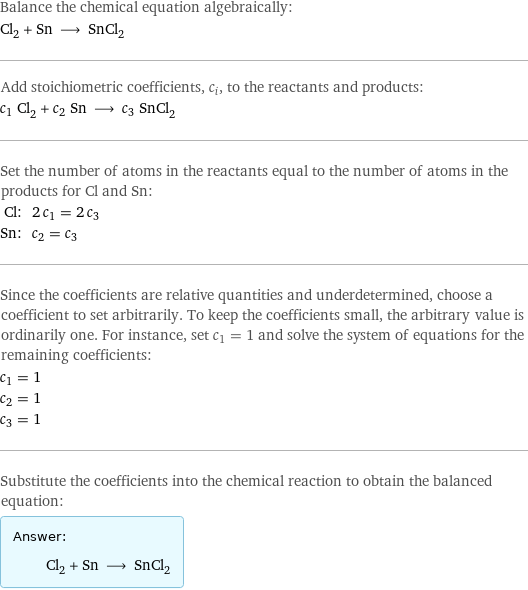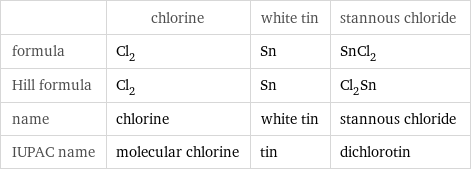Input interpretation

Cl_2 chlorine + Sn white tin ⟶ SnCl_2 stannous chloride
Balanced equation

Balance the chemical equation algebraically: Cl_2 + Sn ⟶ SnCl_2 Add stoichiometric coefficients, c_i, to the reactants and products: c_1 Cl_2 + c_2 Sn ⟶ c_3 SnCl_2 Set the number of atoms in the reactants equal to the number of atoms in the products for Cl and Sn: Cl: | 2 c_1 = 2 c_3 Sn: | c_2 = c_3 Since the coefficients are relative quantities and underdetermined, choose a coefficient to set arbitrarily. To keep the coefficients small, the arbitrary value is ordinarily one. For instance, set c_1 = 1 and solve the system of equations for the remaining coefficients: c_1 = 1 c_2 = 1 c_3 = 1 Substitute the coefficients into the chemical reaction to obtain the balanced equation: Answer: | | Cl_2 + Sn ⟶ SnCl_2
Structures

+ ⟶
Names

chlorine + white tin ⟶ stannous chloride
Equilibrium constant
![Construct the equilibrium constant, K, expression for: Cl_2 + Sn ⟶ SnCl_2 Plan: • Balance the chemical equation. • Determine the stoichiometric numbers. • Assemble the activity expression for each chemical species. • Use the activity expressions to build the equilibrium constant expression. Write the balanced chemical equation: Cl_2 + Sn ⟶ SnCl_2 Assign stoichiometric numbers, ν_i, using the stoichiometric coefficients, c_i, from the balanced chemical equation in the following manner: ν_i = -c_i for reactants and ν_i = c_i for products: chemical species | c_i | ν_i Cl_2 | 1 | -1 Sn | 1 | -1 SnCl_2 | 1 | 1 Assemble the activity expressions accounting for the state of matter and ν_i: chemical species | c_i | ν_i | activity expression Cl_2 | 1 | -1 | ([Cl2])^(-1) Sn | 1 | -1 | ([Sn])^(-1) SnCl_2 | 1 | 1 | [SnCl2] The equilibrium constant symbol in the concentration basis is: K_c Mulitply the activity expressions to arrive at the K_c expression: Answer: | | K_c = ([Cl2])^(-1) ([Sn])^(-1) [SnCl2] = ([SnCl2])/([Cl2] [Sn])](../image_source/3d47762b2633bb423e76c6d30fb40afe.png)
Construct the equilibrium constant, K, expression for: Cl_2 + Sn ⟶ SnCl_2 Plan: • Balance the chemical equation. • Determine the stoichiometric numbers. • Assemble the activity expression for each chemical species. • Use the activity expressions to build the equilibrium constant expression. Write the balanced chemical equation: Cl_2 + Sn ⟶ SnCl_2 Assign stoichiometric numbers, ν_i, using the stoichiometric coefficients, c_i, from the balanced chemical equation in the following manner: ν_i = -c_i for reactants and ν_i = c_i for products: chemical species | c_i | ν_i Cl_2 | 1 | -1 Sn | 1 | -1 SnCl_2 | 1 | 1 Assemble the activity expressions accounting for the state of matter and ν_i: chemical species | c_i | ν_i | activity expression Cl_2 | 1 | -1 | ([Cl2])^(-1) Sn | 1 | -1 | ([Sn])^(-1) SnCl_2 | 1 | 1 | [SnCl2] The equilibrium constant symbol in the concentration basis is: K_c Mulitply the activity expressions to arrive at the K_c expression: Answer: | | K_c = ([Cl2])^(-1) ([Sn])^(-1) [SnCl2] = ([SnCl2])/([Cl2] [Sn])
Rate of reaction
![Construct the rate of reaction expression for: Cl_2 + Sn ⟶ SnCl_2 Plan: • Balance the chemical equation. • Determine the stoichiometric numbers. • Assemble the rate term for each chemical species. • Write the rate of reaction expression. Write the balanced chemical equation: Cl_2 + Sn ⟶ SnCl_2 Assign stoichiometric numbers, ν_i, using the stoichiometric coefficients, c_i, from the balanced chemical equation in the following manner: ν_i = -c_i for reactants and ν_i = c_i for products: chemical species | c_i | ν_i Cl_2 | 1 | -1 Sn | 1 | -1 SnCl_2 | 1 | 1 The rate term for each chemical species, B_i, is 1/ν_i(Δ[B_i])/(Δt) where [B_i] is the amount concentration and t is time: chemical species | c_i | ν_i | rate term Cl_2 | 1 | -1 | -(Δ[Cl2])/(Δt) Sn | 1 | -1 | -(Δ[Sn])/(Δt) SnCl_2 | 1 | 1 | (Δ[SnCl2])/(Δt) (for infinitesimal rate of change, replace Δ with d) Set the rate terms equal to each other to arrive at the rate expression: Answer: | | rate = -(Δ[Cl2])/(Δt) = -(Δ[Sn])/(Δt) = (Δ[SnCl2])/(Δt) (assuming constant volume and no accumulation of intermediates or side products)](../image_source/901893bd73890100c81e43ed6c24fac4.png)
Construct the rate of reaction expression for: Cl_2 + Sn ⟶ SnCl_2 Plan: • Balance the chemical equation. • Determine the stoichiometric numbers. • Assemble the rate term for each chemical species. • Write the rate of reaction expression. Write the balanced chemical equation: Cl_2 + Sn ⟶ SnCl_2 Assign stoichiometric numbers, ν_i, using the stoichiometric coefficients, c_i, from the balanced chemical equation in the following manner: ν_i = -c_i for reactants and ν_i = c_i for products: chemical species | c_i | ν_i Cl_2 | 1 | -1 Sn | 1 | -1 SnCl_2 | 1 | 1 The rate term for each chemical species, B_i, is 1/ν_i(Δ[B_i])/(Δt) where [B_i] is the amount concentration and t is time: chemical species | c_i | ν_i | rate term Cl_2 | 1 | -1 | -(Δ[Cl2])/(Δt) Sn | 1 | -1 | -(Δ[Sn])/(Δt) SnCl_2 | 1 | 1 | (Δ[SnCl2])/(Δt) (for infinitesimal rate of change, replace Δ with d) Set the rate terms equal to each other to arrive at the rate expression: Answer: | | rate = -(Δ[Cl2])/(Δt) = -(Δ[Sn])/(Δt) = (Δ[SnCl2])/(Δt) (assuming constant volume and no accumulation of intermediates or side products)
Chemical names and formulas

| chlorine | white tin | stannous chloride formula | Cl_2 | Sn | SnCl_2 Hill formula | Cl_2 | Sn | Cl_2Sn name | chlorine | white tin | stannous chloride IUPAC name | molecular chlorine | tin | dichlorotin
Substance properties

| chlorine | white tin | stannous chloride molar mass | 70.9 g/mol | 118.71 g/mol | 189.6 g/mol phase | gas (at STP) | solid (at STP) | solid (at STP) melting point | -101 °C | 231.9 °C | 246 °C boiling point | -34 °C | 2602 °C | 652 °C density | 0.003214 g/cm^3 (at 0 °C) | 7.31 g/cm^3 | 3.354 g/cm^3 solubility in water | | insoluble | dynamic viscosity | | 0.001 Pa s (at 600 °C) | 7 Pa s (at 25 °C) odor | | odorless | odorless
Units
